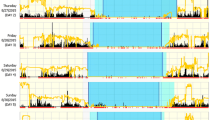Abstract
Purpose
While actigraphy has gained popularity in pediatric sleep research, questions remain about the validity of actigraphy as an estimate of sleep-wake patterns. In particular, there is little consistency in the field in terms of scoring rules used to determine sleep onset latency. The purpose of this study was to evaluate different criteria of immobility as a measure of sleep onset latency in children and adolescents.
Methods
Ninety-five youth (ages 3–17 years, 46 % male) wore both the Ambulatory Monitoring Inc. Motionlogger Sleep Watch (AMI) and the Philips Respironics Mini-Mitter Actiwatch-2 (PRMM) during overnight polysomnography in a pediatric sleep lab. We examined different sleep onset latency scoring rules (3, 5, 10, 15, and 20 min of immobility) using different algorithms (Sadeh and Cole-Kripke) and sensitivity settings (low, medium, high) for the devices. Comparisons were also made across age groups (preschoolers, school-aged, adolescents) and sleep disordered breathing status (no obstructive sleep apnea [OSA], mild OSA, clinically significant OSA).
Results
For the AMI device, shorter scoring rules performed best for children and longer scoring rules were better for adolescents, with shorter scoring rules best across sleep disordered breathing groups. For the PRMM device, medium to longer scoring rules performed best across age and sleep disordered breathing groups.
Conclusions
Researchers are encouraged to determine the scoring rule that best fits their population of interest. Future studies are needed with larger samples of children and adolescents to further validate actigraphic immobility as a proxy for sleep onset latency.




Similar content being viewed by others
References
Sadeh A (2011) The role and validity of actigraphy in sleep medicine: an update. Sleep Med Rev 15:259–267
Meltzer LJ, Montgomery-Downs HE, Insana SP, Walsh CM (2012) Use of actigraphy for assessment in pediatric sleep research. Sleep Med Rev 16:463–475
Ancoli-Israel S, Cole R, Alessi C, Chambers M, Moorcroft W, Pollak CP (2003) The role of actigraphy in the study of sleep and circadian rhythms. Sleep 26:342–392
Chae KY, Kripke DF, Poceta JS, Shadan F, Jamil SM, Cronin JW, Kline LE (2009) Evaluation of immobility time for sleep latency in actigraphy. Sleep Med 10:621–625
Meltzer LJ, Walsh CM, Traylor J, Westin AM (2012) Direct comparison of two new actigraphs and polysomnography in children and adolescents. Sleep 35:159–166
Iber C, Ancoli-Israel S, Chesson AL Jr, Quan SF, for the American Academy of Sleep Medicine (2007) The AASM manual for the scoring of sleep and associated events. American Academy of Sleep Medicine, Westchester, IL
Sadeh A, Sharkey KM, Carskadon MA (1994) Activity-based sleep-wake identification: an empirical test of methodological issues. Sleep 17:201–207
Cole RJ, Kripke DF, Gruen W, Mullaney DJ, Gillin JC (1992) Automatic sleep/wake identification from wrist activity. Sleep 15:461–469
Morgenthaler TI, Alessi C, Friedman L, Owens J, Kapur V, Boehlecke B, Brown T, Chesson A Jr, Coleman J, Lee-Chiong T, Pancer J, Swick TJ (2007) Practice parameters for the use of actigraphy in the assessment of sleep and sleep disorders: an update for 2007. Sleep 30:519–529
Jenni OG, Carskadon MA (2005) Normal human sleep at different ages: infants to adolescents. SRS Basics of Sleep Guide. Sleep Researcher Society, Westchester, IL, pp 11–19
Kurth S, Ringli M, Geiger A, LeBourgeois M, Jenni OG, Huber R (2010) Mapping of cortical activity in the first two decades of life: a high-density sleep electroencephalogram study. J Neurosci 30:13211–13219
Katz ES, Marcus CL (2005) Diagnosis of obstructive sleep apnea syndrome in infants and children. In: Sheldon SH, Ferber R, Kryger MH (eds) Principles and practice of pediatric sleep medicine. Elsevier Saunders, Philadelphia, pp 197–210
Witmans MB, Keens TG, Davidson Ward SL, Marcus CL (2003) Obstructive hypopneas in children and adolescents: normal values. Am J Respir Crit Care Med 168:1540
Traeger N, Schultz B, Pollock AN, Mason T, Marcus CL, Arens R (2005) Polysomnographic values in children 2-9 years old: additional data and review of the literature. Pediatr Pulmonol 40:22–30
Uliel S, Tauman R, Greenfeld M, Sivan Y (2004) Normal polysomnographic respiratory values in children and adolescents. Chest 125:872–878
Marcus CL, Brooks LJ, Ward SD, Draper KA, Gozal D, Halbower AC, Jones J, Lehmann C, Schechter MS, Sheldon S, Shiffman RN, Spruyt K (2012) Diagnosis and management of childhood obstructive sleep apnea syndrome. Pediatrics 130:e714–e755
Acknowledgments
The authors thank the children and families who participated in this study, the Children’s Hospital of Philadelphia Sleep Lab for their assistance with this project, and Hawley Montgomery-Downs for her helpful review and comments on this paper. This study was funded in part by NIH MH077662.
Conflict of interest
The authors declare that they have no conflict of interest.
Author information
Authors and Affiliations
Corresponding author
Rights and permissions
About this article
Cite this article
Meltzer, L.J., Walsh, C.M. & Peightal, A.A. Comparison of actigraphy immobility rules with polysomnographic sleep onset latency in children and adolescents. Sleep Breath 19, 1415–1423 (2015). https://doi.org/10.1007/s11325-015-1138-6
Received:
Revised:
Accepted:
Published:
Issue Date:
DOI: https://doi.org/10.1007/s11325-015-1138-6




